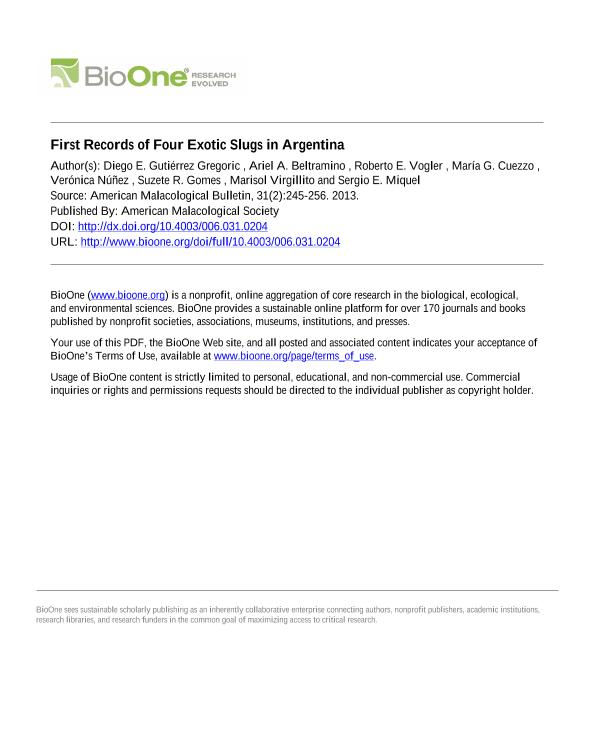Mostrar el registro sencillo del ítem
dc.contributor.author
Gutierrez Gregoric, Diego Eduardo

dc.contributor.author
Beltramino, Ariel Anibal

dc.contributor.author
Vogler, Roberto Eugenio

dc.contributor.author
Cuezzo, Maria Gabriela

dc.contributor.author
Nuñez, Maria Veronica

dc.contributor.author
Gomes, Suzete Rodrigues

dc.contributor.author
Virgillito, Marisol
dc.contributor.author
Miquel, Sergio Eduardo

dc.date.available
2017-11-01T16:07:28Z
dc.date.issued
2013-08
dc.identifier.citation
Gutierrez Gregoric, Diego Eduardo; Beltramino, Ariel Anibal; Vogler, Roberto Eugenio; Cuezzo, Maria Gabriela; Nuñez, Maria Veronica; et al.; First records of four exotic slugs in Argentina; American Malacological Society; American Malacological Bulletin; 31; 2; 8-2013; 245-256
dc.identifier.issn
0740-2783
dc.identifier.uri
http://hdl.handle.net/11336/27316
dc.description.abstract
This paper reports for the first time the occurrence of four exotic terrestrial slug species in Argentina: Lehmannia valentiana (Férussac, 1823) (Limacidae), Deroceras invadens Reise et al. 2011 (Agriolimacidae), Arion intermedius Normand, 1852 (Arionidae) and Meghimatium pictum (Stolyczka, 1873) (Philomycidae). The study is based on specimens deposited in museums in Argentina. Both the morphologic characteristics and the mitochondrial cytochrome oxidase I gene sequences were used to identify the exotic species. Phylogenetic analyses were also carried out in order to explore the location of their origins. Lehmannia valentiana had the oldest records and has been widely distributed in Argentina. Deroceras invadens and A. intermedius were found to be restricted to the southern portion of the country. Meghimatium pictum was recorded in the northwest and northeast Argentina, and the DNA sequences analyzed from this species were more closely related to specimens from the west of the Strait of Taiwan. A determination of the origin of the other species was impossible because either the sequences analyzed grouped with samples from different geographical origins or only few sequences were available for comparison. In view of the invasive potential of these slug species, the present work provides new and potentially useful DNA sequence data obtained from morphologically-confirmed specimens. Information provided from these analyses should assist in making a rapid identification of these exotic slugs by nonspecialists and governmental authorities who are responsible for managing and controlling the presence of exotic species.
dc.format
application/pdf
dc.language.iso
eng
dc.publisher
American Malacological Society

dc.rights
info:eu-repo/semantics/openAccess
dc.rights.uri
https://creativecommons.org/licenses/by-nc-sa/2.5/ar/
dc.subject
Arion Intermedius
dc.subject
Deroceras Invadens
dc.subject
Lehmannia Valentiana
dc.subject
Meghimatium Pictum
dc.subject
Molecular Phylogenetic Analyses
dc.subject.classification
Bioquímica y Biología Molecular

dc.subject.classification
Ciencias Biológicas

dc.subject.classification
CIENCIAS NATURALES Y EXACTAS

dc.title
First records of four exotic slugs in Argentina
dc.type
info:eu-repo/semantics/article
dc.type
info:ar-repo/semantics/artículo
dc.type
info:eu-repo/semantics/publishedVersion
dc.date.updated
2015-10-15T20:09:38Z
dc.identifier.eissn
2162-2698
dc.journal.volume
31
dc.journal.number
2
dc.journal.pagination
245-256
dc.journal.pais
Estados Unidos

dc.journal.ciudad
Washington DC
dc.description.fil
Fil: Gutierrez Gregoric, Diego Eduardo. Consejo Nacional de Investigaciones Científicas y Técnicas. Centro Científico Tecnológico Conicet - La Plata; Argentina. Universidad Nacional de La Plata. Facultad de Ciencias Naturales y Museo. División de Zoología Invertebrados; Argentina
dc.description.fil
Fil: Beltramino, Ariel Anibal. Consejo Nacional de Investigaciones Científicas y Técnicas. Centro Científico Tecnológico Conicet - La Plata; Argentina. Universidad Nacional de La Plata. Facultad de Ciencias Naturales y Museo. División de Zoología Invertebrados; Argentina. Ministerio de Ciencia. Tecnología e Innovación Productiva. Agencia Nacional de Promoción Cientifíca y Tecnológica; Argentina
dc.description.fil
Fil: Vogler, Roberto Eugenio. Consejo Nacional de Investigaciones Científicas y Técnicas. Centro Científico Tecnológico Conicet - La Plata; Argentina. Universidad Nacional de La Plata. Facultad de Ciencias Naturales y Museo. División de Zoología Invertebrados; Argentina
dc.description.fil
Fil: Cuezzo, Maria Gabriela. Consejo Nacional de Investigaciones Científicas y Técnicas. Centro Científico Tecnológico Conicet - Tucumán. Instituto de Biodiversidad Neotropical. Universidad Nacional de Tucumán. Facultad de Ciencias Naturales e Instituto Miguel Lillo. Instituto de Biodiversidad Neotropical. Instituto de Biodiversidad Neotropical; Argentina
dc.description.fil
Fil: Nuñez, Maria Veronica. Consejo Nacional de Investigaciones Científicas y Técnicas. Centro Científico Tecnológico Conicet - La Plata; Argentina. Universidad Nacional de La Plata. Facultad de Ciencias Naturales y Museo. División de Zoología Invertebrados; Argentina
dc.description.fil
Fil: Gomes, Suzete Rodrigues. National Malacology Laboratory; Estados Unidos. United States Department of Agriculture; Estados Unidos
dc.description.fil
Fil: Virgillito, Marisol. Consejo Nacional de Investigaciones Científicas y Técnicas. Oficina de Coordinación Administrativa Parque Centenario. Museo Argentino de Ciencias Naturales "Bernardino Rivadavia"; Argentina
dc.description.fil
Fil: Miquel, Sergio Eduardo. Consejo Nacional de Investigaciones Científicas y Técnicas. Oficina de Coordinación Administrativa Parque Centenario. Museo Argentino de Ciencias Naturales "Bernardino Rivadavia"; Argentina
dc.journal.title
American Malacological Bulletin

dc.relation.alternativeid
info:eu-repo/semantics/altIdentifier/doi/http://dx.doi.org/10.4003/006.031.0204
dc.relation.alternativeid
info:eu-repo/semantics/altIdentifier/url/http://www.bioone.org/doi/abs/10.4003/006.031.0204
Archivos asociados
